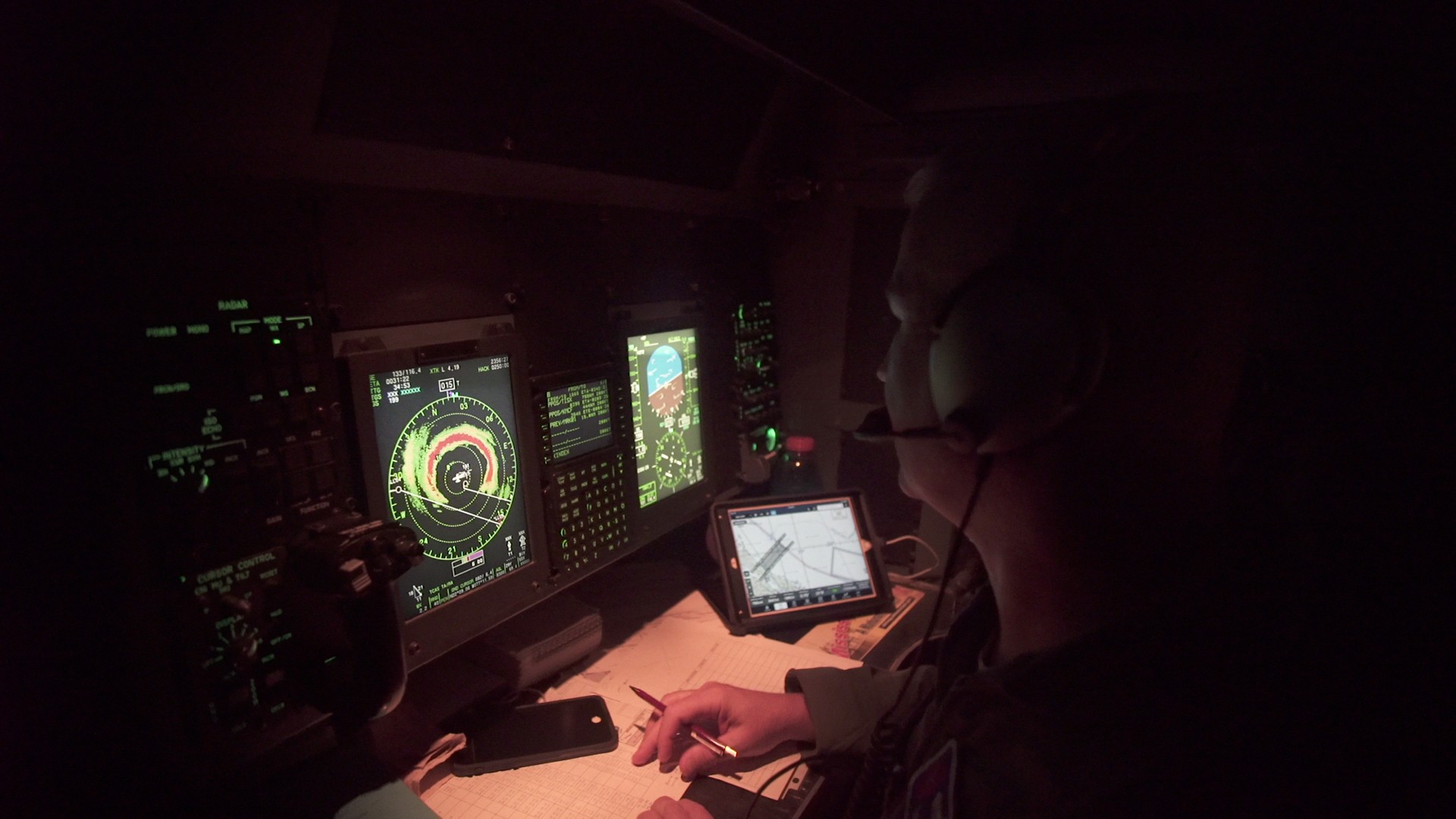Scott Price. Foto via National Oceanic and Atmospheric Administration
On the first day of flight training, pilots are often taught the importance of avoiding weather in order to achieve the smoothest ride possible. Steering a plane directly into and through deadly hurricanes would appear to be at odds with that maxim. But that's a normal day's work for the pilots in the "Hurricane Hunter" division of the National Oceanic and Atmospheric Administration (NOAA), who along with the 53rd Weather Reconnaissance Squadron of the US Air Force conduct some of America's more daring official meteorology.It's been a busy few weeks for the NOAA Corps, with Hurricanes Harvey, Irma, Jose and, now, Maria devastating the Gulf of Mexico and Caribbean. The latter storm has killed at least ten people in Puerto Rico and brought infrastructure crisis to the US island territory, where residents could be without power for months.As a lead pilot for nine years, Commander Scott Price has punched through more hurricane eye-walls than he can recall. ("About 140," he eventually estimated.) Officers like Price pilot and navigate the planes, while civilian members* of the NOAA—generally a team of 16, including engineers, technicians, and aircraft maintainers—make sure the hurricane data is collected.I asked Price what it's like flying into hurricanes professionally—and how close he's come to disaster. Here's what he told me.
The best data about the storm is in the storm itself, so we fly in and discharge sensors, which collect data like wind speed, direction, pressure, temperature, and humidity. We drop them, and, as they fall through the air column, it radios that data back to the plane, and we send that to the folks that generate the forecasts. That way, we get an accurate product out to the public with which they can make decisions. Evacuate, don't evacuate, shutter businesses—our interest is to get the very best information to the public for decision-making purposes.Often, we'll fly two or three missions in a row. Each runs about nine hours. For Jose, we did a mission, landed, and gave the airplane to another crew that did a follow-up mission. My crew took off at four in the afternoon, landed at midnight, and the next crew took off at four in the morning, landing at noon. On average, we get about 48 hours notice that we'll be flying.

NOAA has a couple of different airplanes that we refer to as the Hurricane Hunters. One is a Gulf Stream IV. It's twin engine, high-altitude, typically flying between 40,000 and 45,000 feet, normally sampling the atmosphere around the storm and the external influences that help drive the hurricane around. Every once in a while, we'll use it to cross the top of the storm, but typically they're for the outskirts. The other type of plane we use is the P-3 Orion. The Navy uses them predominantly for anti-submarine warfare or reconnaissance, and we use them to penetrate the hurricane eye-wall.People think of it being very calm in the eye, and that can certainly be the case. Irma is a good example: It went from a Category Two (96 to 110 MPH) to a Category Five (over 156 MPH). It was relatively calm in the center, but the eye-wall itself was a Category Five. As you fly in, your wind speed picks up and up, and you punch through the eye-wall. Inside, it's relatively calm and smooth. While we're in the eye, we to try to find the back pressure center of the storm, which helps with the forecast. Once we find that, we get back on our track outbound and exit the other side. We're not in the eye very long. In younger storms—the tropical storms, or lower-level hurricanes—the eye can be turbulent. So, it all depends on the storm. But in the hurricanes people think about, a well-formed eye is often a softer ride.A hurricane is definitely a turbulent ride. But the airplane we have is well fitted for it. It's an older airplane that can take a beating. They definitely don't make them like they used to. But even a 120,000-pound airplane can get knocked around pretty good. When we flew Jose, it was only a Category One (74 to 95 MPH), so it wasn't well-formed. But there were a lot of convection fields of updraft and downdraft, which equated to a lot of turbulence. In the course of two hours, we were unable to turn the seatbelt lights off, so we had everyone strapped in. It was tiring and exhausting enough trying to keep the plane upright and to put it where we need to collect the very best data. But then the flight after that, six or seven hours later, they experienced a totally different storm.We have limitations in place for what we're allowed to fly in. The airplane is extremely rugged and can take beatings, but we need to protect it. If we hit a certain wind speed, we'll abort. I personally have not been on a flight where we had to… wait, I take that back. We got bounced around pretty good once and had to abort. The plane was just fine, but a precautionary limit is built into our policy to protect the airplane. We have to use the plane again on the next flight. There's always another storm on the horizon.The worst-case scenario is to experience some sort of aircraft malfunction while we're in that environment. I've been extremely fortunate, in that I haven't had any significant issues. Well, we have had fires of unknown origin, something in the airplane catches fire or starts to smoke. We have emergency procedures to handle that, but it's particularly challenging because it involves people taking the focus away from the hurricane itself. I've had two of those in the hurricane environment, not at the worst time, but we had to stop focusing on the hurricane. Also, I once experienced an indication of what would be an engine failure. It wasn't at the worst possible time, but we're in the storm to collect the data, and to do it safely. If you can't collect the data and get safely out the other side, there's no point in being there.This account has been lightly edited and condensed for clarity.*Correction 09/25/2017: An earlier version of this article incorrectly stated that civilians who take part in NOAA "Hurricane Hunter" flights are, like the pilots and navigators, members of the NOAA Corps, rather than the broader NOAA. We regret the error.Follow Rick Paulas on Twitter.
Advertisement
The best data about the storm is in the storm itself, so we fly in and discharge sensors, which collect data like wind speed, direction, pressure, temperature, and humidity. We drop them, and, as they fall through the air column, it radios that data back to the plane, and we send that to the folks that generate the forecasts. That way, we get an accurate product out to the public with which they can make decisions. Evacuate, don't evacuate, shutter businesses—our interest is to get the very best information to the public for decision-making purposes.Often, we'll fly two or three missions in a row. Each runs about nine hours. For Jose, we did a mission, landed, and gave the airplane to another crew that did a follow-up mission. My crew took off at four in the afternoon, landed at midnight, and the next crew took off at four in the morning, landing at noon. On average, we get about 48 hours notice that we'll be flying.
Advertisement

NOAA has a couple of different airplanes that we refer to as the Hurricane Hunters. One is a Gulf Stream IV. It's twin engine, high-altitude, typically flying between 40,000 and 45,000 feet, normally sampling the atmosphere around the storm and the external influences that help drive the hurricane around. Every once in a while, we'll use it to cross the top of the storm, but typically they're for the outskirts. The other type of plane we use is the P-3 Orion. The Navy uses them predominantly for anti-submarine warfare or reconnaissance, and we use them to penetrate the hurricane eye-wall.People think of it being very calm in the eye, and that can certainly be the case. Irma is a good example: It went from a Category Two (96 to 110 MPH) to a Category Five (over 156 MPH). It was relatively calm in the center, but the eye-wall itself was a Category Five. As you fly in, your wind speed picks up and up, and you punch through the eye-wall. Inside, it's relatively calm and smooth. While we're in the eye, we to try to find the back pressure center of the storm, which helps with the forecast. Once we find that, we get back on our track outbound and exit the other side. We're not in the eye very long. In younger storms—the tropical storms, or lower-level hurricanes—the eye can be turbulent. So, it all depends on the storm. But in the hurricanes people think about, a well-formed eye is often a softer ride.
Advertisement
